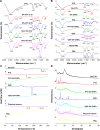Paclitaxel and quercetin nanoparticles co-loaded in microspheres to prolong retention time for pulmonary drug delivery
- PMID: 29180863
- PMCID: PMC5691910
- DOI: 10.2147/IJN.S147028
Paclitaxel and quercetin nanoparticles co-loaded in microspheres to prolong retention time for pulmonary drug delivery
Abstract
High drug resistance, poor water solubility, short half-life, and low local drug concentration are obstacles for successful delivery of chemotherapeutic drugs for lung cancer. A new method involving the use of nanoparticles (NPs) for pulmonary delivery is proposed. However, use of NPs is limited by the particle size range for pulmonary drug delivery considering that NPs cannot be deposited directly into the lungs. NPs polymerized into microspheres (polymeric microspheres, PMs) will result in suitable particle sizes and retain the advantages of nanodrugs after redispersion when applied in pulmonary delivery. We report the development of novel NPs in the form of PMs loaded with paclitaxel (PTX) and quercetin (QUE) double drugs based on the synthesis of oleic acid-conjugated chitosan (OA-CTS) for pulmonary delivery. This approach is aimed toward prolonging PTX retention time in the presence of QUE and bypassing P-glycoprotein drug efflux pumps. NPs loaded with PTX or QUE were prepared with 11% substitution degree using OA-CTS as the carrier by ionic cross-linking method, which NPs loaded with PTX or QUE were used in the preparation of PMs by spray-drying. The diameters of the PMs ranged from 1 to 5 μm which had uniform size range. Scanning electron microscopy showed that PMs were polymers formed by a large number of NPs and readily redispersed (after redispersion, size of NPs ranged between 250 and 350 nm) in water within 1 h. PMs displayed slow-release characteristics at pH 4.5 and 7.4. The in vivo pharmacokinetic and biodistribution studies suggested that PMs exhibit prolonged circulation time and a markedly high accumulation in the lung. The obtained results indicate that PMs can serve as a promising pulmonary delivery system for combined pharmacotherapy using hydrophobic anticancer drugs.
Keywords: nanoparticles; oleic acid-conjugated chitosan; paclitaxel; polymeric microspheres; pulmonary delivery; quercetin.
Conflict of interest statement
Disclosure The authors report no conflicts of interest in this work.
Figures








Similar articles
-
Amphiphilic carboxymethyl chitosan-quercetin conjugate with P-gp inhibitory properties for oral delivery of paclitaxel.Biomaterials. 2014 Aug;35(26):7654-65. doi: 10.1016/j.biomaterials.2014.05.053. Epub 2014 Jun 11. Biomaterials. 2014. PMID: 24927684
-
Targeted delivery of quercetin by nanoparticles based on chitosan sensitizing paclitaxel-resistant lung cancer cells to paclitaxel.Mater Sci Eng C Mater Biol Appl. 2021 Feb;119:111442. doi: 10.1016/j.msec.2020.111442. Epub 2020 Aug 25. Mater Sci Eng C Mater Biol Appl. 2021. PMID: 33321583
-
The preparation, characterization, and pharmacokinetic studies of chitosan nanoparticles loaded with paclitaxel/dimethyl-β-cyclodextrin inclusion complexes.Int J Nanomedicine. 2015 Jul 3;10:4309-19. doi: 10.2147/IJN.S83508. eCollection 2015. Int J Nanomedicine. 2015. PMID: 26170666 Free PMC article.
-
Quercetin Loaded Nanoparticles in Targeting Cancer: Recent Development.Anticancer Agents Med Chem. 2019;19(13):1560-1576. doi: 10.2174/1871520619666190705150214. Anticancer Agents Med Chem. 2019. PMID: 31284873 Review.
-
Dry Powder form of Polymeric Nanoparticles for Pulmonary Drug Delivery.Curr Pharm Des. 2016;22(17):2549-60. doi: 10.2174/1381612822666160128150449. Curr Pharm Des. 2016. PMID: 26818872 Review.
Cited by
-
The Role of Inhaled Chitosan-Based Nanoparticles in Lung Cancer Therapy.Pharmaceutics. 2024 Jul 23;16(8):969. doi: 10.3390/pharmaceutics16080969. Pharmaceutics. 2024. PMID: 39204314 Free PMC article. Review.
-
A novel ligand-modified nanocomposite microparticles improved efficiency of quercetin and paclitaxel delivery in the non-small cell lung cancer.Drug Deliv. 2022 Dec;29(1):3123-3133. doi: 10.1080/10717544.2022.2120567. Drug Deliv. 2022. PMID: 36151722 Free PMC article.
-
A combination of chitosan nanoparticles loaded with celecoxib and kartogenin has anti-inflammatory and chondroprotective effects: Results from an in vitro model of osteoarthritis.Heliyon. 2024 May 10;10(10):e31058. doi: 10.1016/j.heliyon.2024.e31058. eCollection 2024 May 30. Heliyon. 2024. PMID: 38803939 Free PMC article.
-
Application of quercetin flavonoid based hybrid nanocomposites: A review.Saudi Pharm J. 2020 Dec;28(12):1719-1732. doi: 10.1016/j.jsps.2020.10.017. Epub 2020 Nov 6. Saudi Pharm J. 2020. PMID: 33424263 Free PMC article. Review.
-
Recent Advances in Functionalized Nanoparticles in Cancer Theranostics.Nanomaterials (Basel). 2022 Aug 17;12(16):2826. doi: 10.3390/nano12162826. Nanomaterials (Basel). 2022. PMID: 36014691 Free PMC article. Review.
References
-
- Schiller JH, Harrington D, Belani CP, et al. Eastern Cooperative Oncology Group Comparison of four chemotherapy regimens for advanced non-small-cell lung cancer. N Engl J Med. 2002;346(2):92–98. - PubMed
-
- Nascimento AV, Bousbaa H, Ferreira D, Sarmento B. Non-small cell lung carcinoma: an overview on targeted therapy. Curr Drug Targets. 2015;16(13):1448–1463. - PubMed
-
- Rowinsky EK, Onetto N, Canetta RM, Arbuck SG. Taxol: the first of the taxanes, an important new class of antitumor agents. Semin Oncol. 1992;19(6):646–662. - PubMed
-
- Václavíková R, Horský S, Simek P, Gut I. Paclitaxel metabolism in rat and human liver microsomes is inhibited by phenolic antioxidants. Naunyn Schmiedebergs Arch Pharmacol. 2003;368(3):200–209. - PubMed
MeSH terms
Substances
LinkOut - more resources
Full Text Sources
Other Literature Sources
Research Materials

